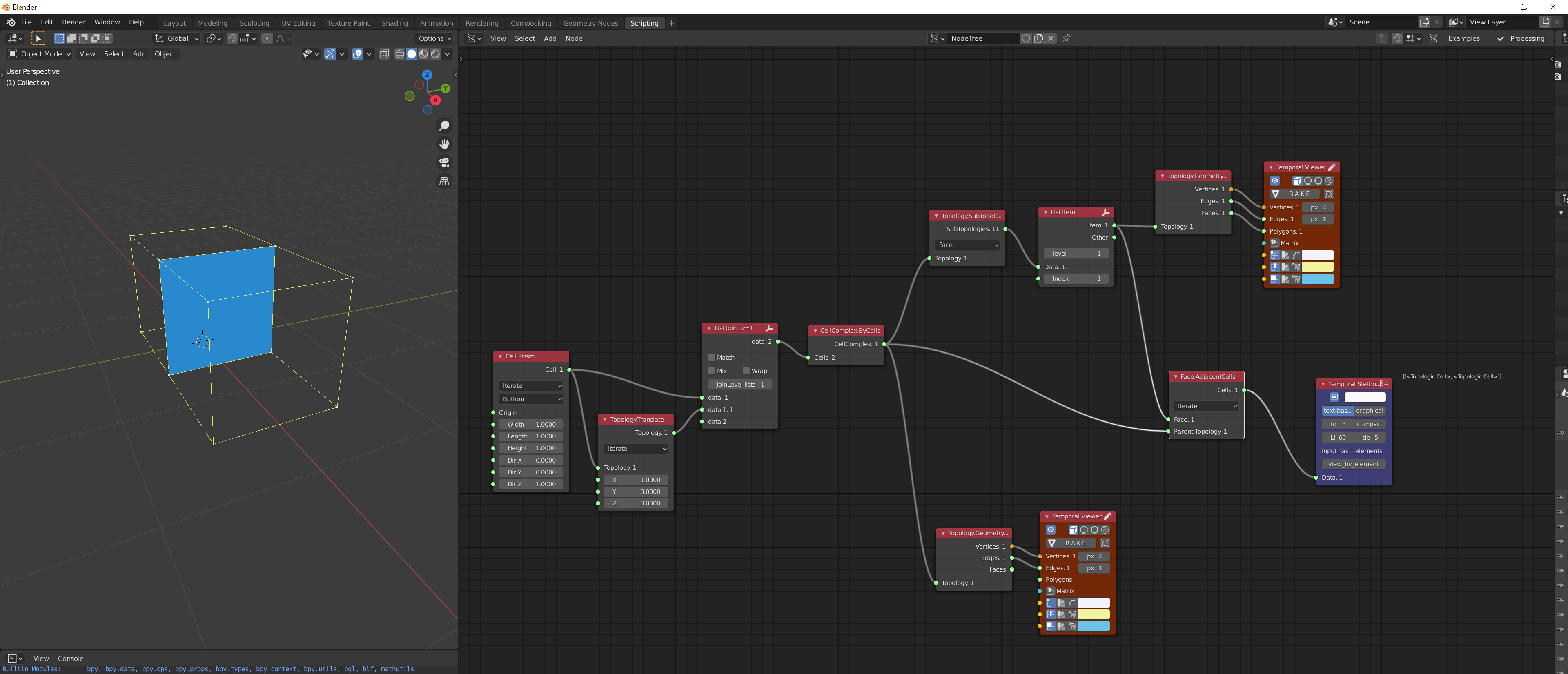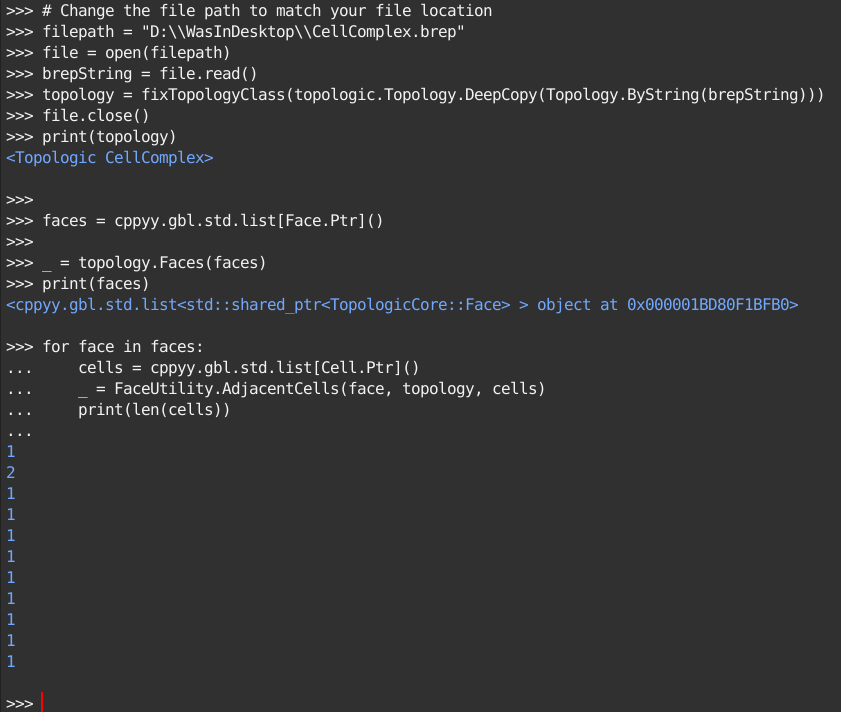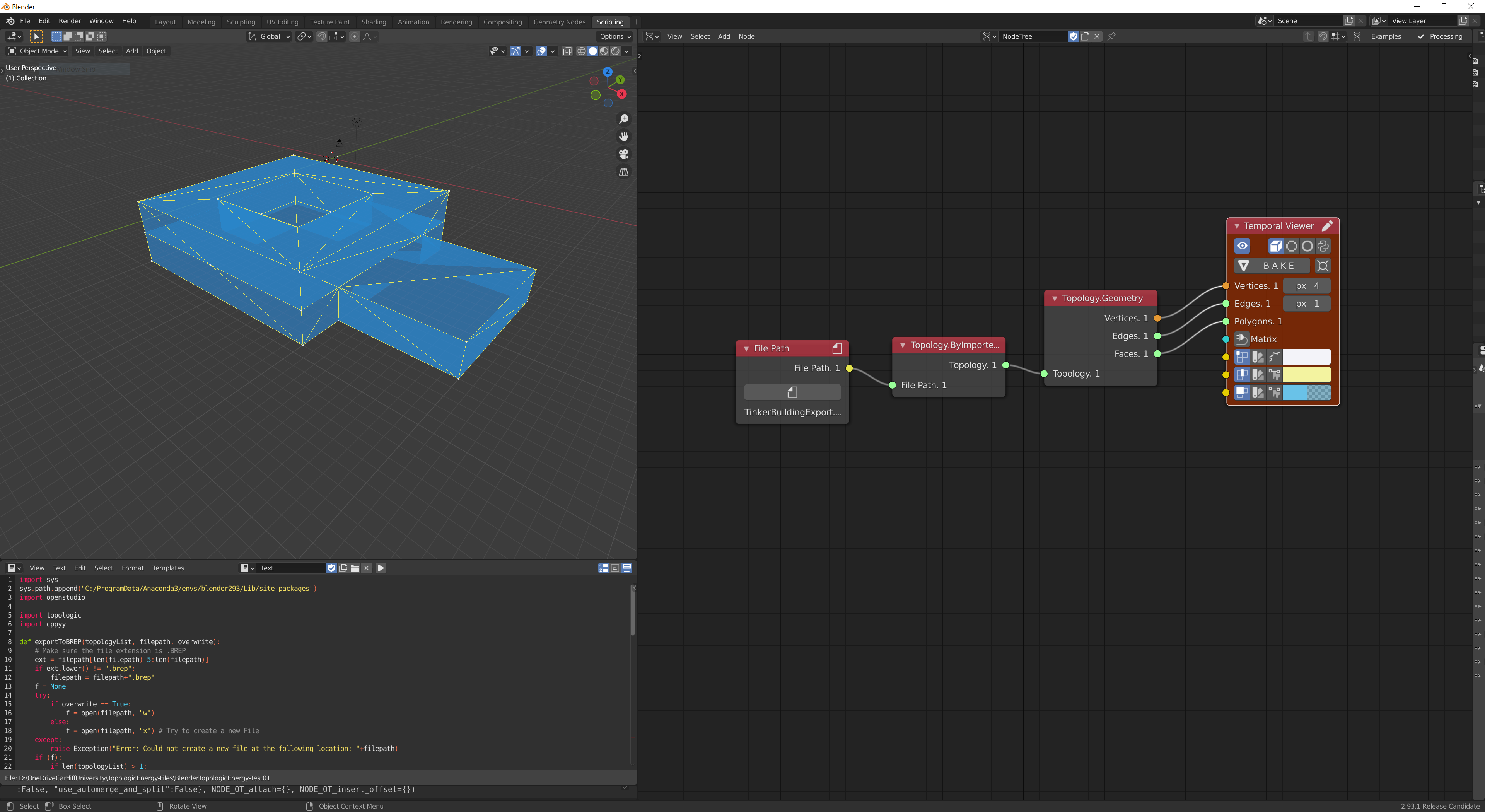@agonzalezesteve I just tried it in sverchok and Face.AdjacentCells worked perfectly. Here is the screen shot. Notice that it produces the two cell (in stethoscope) when the middle face is asked for its adjacent cells.

@agonzalezesteve I just tried it in sverchok and Face.AdjacentCells worked perfectly. Here is the screen shot. Notice that it produces the two cell (in stethoscope) when the middle face is asked for its adjacent cells.

@topologic Sverchok node are fine. I have problems using this method in a script.
Can you check the file I attach please?
@agonzalezesteve said:
@topologic Sverchok node are fine. I have problems using this method in a script.
Can you check the file I attach please?
I will soon but you could also look at the python behind that node and see how to call that method. If it works in sverchok, it will work in a python script.
@agonzalezesteve said:
@topologic Sverchok node are fine. I have problems using this method in a script.
Can you check the file I attach please?
Your code is failing on line 106:
File "\Text", line 106, in <module>
AttributeError: 'NoneType' object has no attribute 'by_type'
which is
for build_elem in ifc_file.by_type('IfcBuildingElement'):
ifc_file = IfcStore.get_file()
is returning None. What should this call return?
an ifcopenshell file object, you may use "create project" operator in scene properties.
Can you send me the simplest non ifc related code that fails? Would make it easier to debug. I honestly doubt it is a bug with Topologic because the same call in sverchok python code is working fine.
Dear @agonzalezesteve I just tested a python script (see below) and it works fine. Please check this code. You need to change the filepath variable to point it to the correct location of CellComplex.brep on your system. The brep is also attached. It is a basic two-cell CellComplex. So, only one face will report back that it has two adjacent cells. Hope that helps.

@topologic I've found the bug. I had problems with the getSubTopologies method.
@agonzalezesteve ok good. Just to be 100% sure: You mean you found a bug in your code not in Topologic correct?
Question: Can one do energy modelling (heating/cooling loads, thermal comfort etc) within Blender? For example using the ladybug tools? Or is that done outside Blender? If not available, is there value to do that within Blender (thinking of porting my TopologicEnergy Code to Blender this summer, but not sure it is worth the time and effort if other solutions exist).
@topologic I was using this method and I had problems with making DeepCopys because SubTopologies were then disconnected from the original topology.
@agonzalezesteve said:
@topologic I was using this method and I had problems with making DeepCopys because SubTopologies were then disconnected from the original topology.
Yup understood. Yes, a deepcopy copies from the topology downards, but obviously cannot keep it linked to its constituent parents because the parent cannot have duplicate children that occupy exactly the same location. It is a new and different child.
@topologic said:
Question: Can one do energy modelling (heating/cooling loads, thermal comfort etc) within Blender? For example using the ladybug tools? Or is that done outside Blender? If not available, is there value to do that within Blender (thinking of porting my TopologicEnergy Code to Blender this summer, but not sure it is worth the time and effort if other solutions exist).
All I've seen is vi suite which I believe uses older versions of blender. It would be great to have more options. It sounded like there was a effort to port energy modeling from Ladybug tools @Moult?
@edwinguerra said:
All I've seen is vi suite which I believe uses older versions of blender. It would be great to have more options. It sounded like there was a effort to port energy modeling from Ladybug tools @Moult?
Is there anyone on here willing to collaborate with me on porting TopologicEnergy to Blender/sverchok. We have ported it once from Maxscript to C++ and to Dynamo and now with openstudio downloadable as a python module, it should be fairly straightforward to port the code to python and to enhance it.
@topologic said:
Question: Can one do energy modelling (heating/cooling loads, thermal comfort etc) within Blender? For example using the ladybug tools? Or is that done outside Blender? If not available, is there value to do that within Blender (thinking of porting my TopologicEnergy Code to Blender this summer, but not sure it is worth the time and effort if other solutions exist).
Yes. You can. I think right now there is two prototypes: a ladybug module developed by @Moult and Vi-Suite
But both with not to much development.
Ladybug Tools consist of a few systems, branded as Ladybug, Honeybee, Butterfly, and Dragonfly. Of the four, only Ladybug has been ported, then I lost the momentum. Ladybug does not do energy modeling. Honeybee does, but is not yet ported.
I think that a port of the ladybug suite (with honeybee, butterfly and dragonfly) would be a game changer for the opensource arch workflow. So if anyone would be willing to develop the port that would be awesome.
@Sinasta I agree. Perhaps @kaiaurelienzh can help contribute, as he is now on the journey to looking at implementing Sverchok IFC nodes?
@Moult @Sinasta
I'll do what I can but no promises! Added to the list.
Agreed that having the full LBT suite in Blender would be very nice. Esp considering blender is already a mesh based modeller, the synergy with energy analysis could be stronger than with Rhino.
That would be an incredible advantage for the opensource world! Im not at all experienced in coding but i could definitly help with testing and debugging. I don't know if that could help you but Vi-Suite is maybe an interesting example of radiance/openfoam analysis in blender https://github.com/rgsouthall/vi-suite061
@Sinasta there is an existing Ladybug Tools which you can help test. You can download it from the https://blenderbim.org website.
@Moult Thanks for the advice! I already tested iy when you published it last summer. But it hasnt been developed any further since then no?
@Sinasta unfortunately no, it hasn't changed at all since.
First Success. What you are looking at is an .osm file that has been parsed and converted through a @topologicBIM python script to a #brep and displayed in #b3d using the python SDK of #openstudio. My plan this summer is to port my TopologicEnergy code to #b3d and #sverchok
Login or Register to reply.